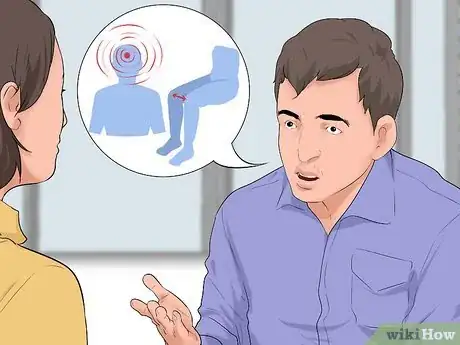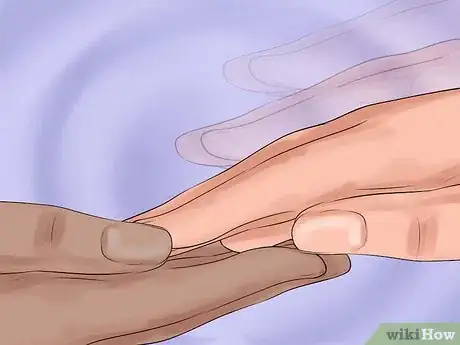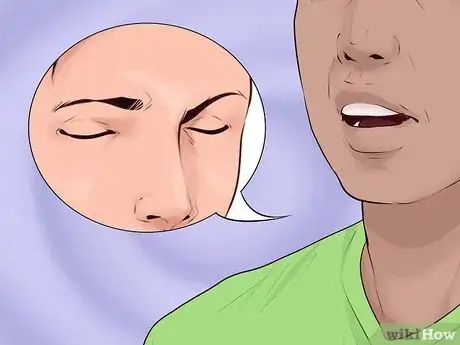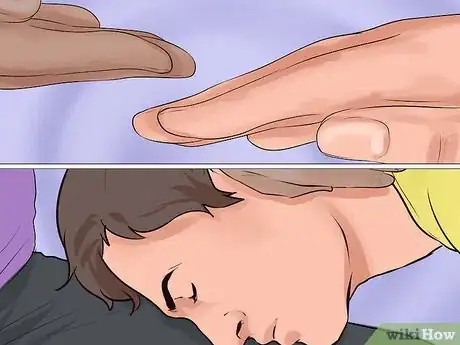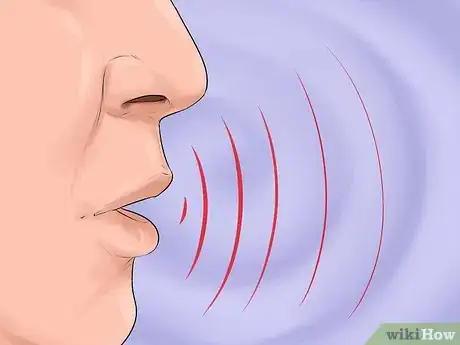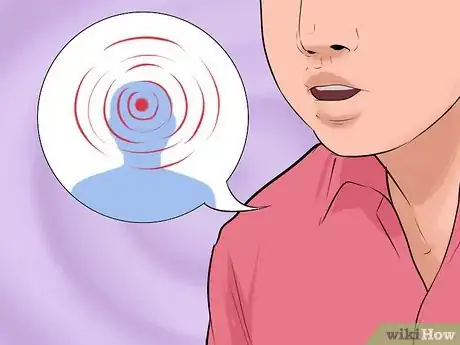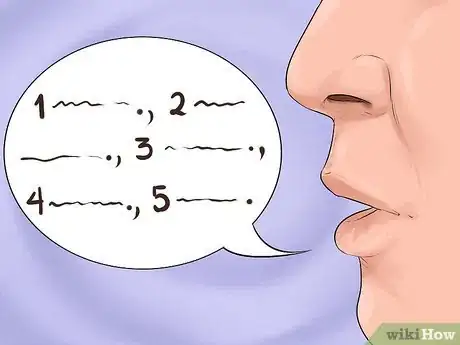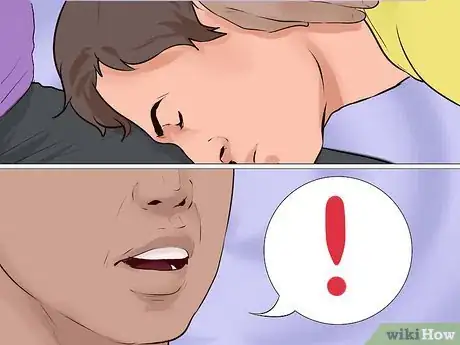This article was co-authored by Stephanie Riseley, MFA. Stephanie Riseley is a Hypnotherapist, Life, and Spiritual Coach based in Los Angeles, California. Stephanie merges neuroscience with spirituality to help people discover their own power and their soul purpose. Certified in Past Life Regression Therapy by the psychiatrist, Brian Weiss, MD, and the Brian Weiss Institute, she also uses Cognitive Behavior Modification and Awareness Therapy to help people heal. With over 30 years of experience, Stephanie conducted research for the DSM III (R), the manual of psychiatric disorders, at UCLA's Neuropsychiatric Institute. She earned a BA from the University of California, Berkeley, and an MFA from the University of California, Los Angeles.
There are 11 references cited in this article, which can be found at the bottom of the page.
wikiHow marks an article as reader-approved once it receives enough positive feedback. In this case, 86% of readers who voted found the article helpful, earning it our reader-approved status.
This article has been viewed 287,309 times.
After hundreds of years of neglect, science is finally giving some attention to hypnosis and concluding that it does in fact, work, if not quite the way people have claimed in the past.[1] It won’t give you control over the person you’ve hypnotized, but it will put him or her in a calmer, more focused state of mind in which extraneous memories and thoughts are often blocked out.[2] It can be an effective way to reduce stress and pain.[3] Inducing hypnosis quickly is often best, because it permits less time for distractions.
Steps
Preparing the Subject for Hypnosis
-
1Practice speaking in a soothing tone. It’s imperative that you talk to your subject in a way that calms and relaxes him or her . Practice speaking slowly, with some rhythm and melody and no harsh or discordant tones. Use this as an opportunity to practice your script; if you struggle with what you want to say during induction it will break the subject’s focus.[4]
- You also should not sound like you’re reading off a script. Practice will help you sound natural.
-
2Prepare your subject mentally and physically. You will want to make sure that he or she is relaxed. Inform him or her that you might touch him or her lightly, so that he or she is not surprised in a way that would cause him or her to break focus. If your subject is wearing a skirt, give her a blanket to put over her legs so that she does not need to worry about the way she positions herself.
- Similarly, tell your subject that is okay if he or she coughs or moves. If he or she is struggling to suppress a biological function, it will likely break his focus.[5]
- Similarly, tell him or her to keep his or her legs uncrossed, otherwise he or she might get caught up by repositioning his or her legs. If he or she is wearing glasses, have him or her remove them.
Advertisement -
3Tell your subject that he or she has nothing to worry about. A distinct sense of fear will prevent him from falling into hypnosis. You want to let him know what you will not be able to manipulate them and that he will not be endangered by the hypnosis.
- Simply indicate "This is a perfectly safe procedure. You will enter into a state of increased relaxation and focus, but you will be in control the entire time."
-
4Ask for permission. Always begin by asking if he or she is ready to be hypnotized. Establishing consent is important for ensuring that he or she is mentally ready and should calm him or her as well.[6]
- When asking for consent, ask the subject about any mental or emotional conditions that might affect their stability under hypnosis. You should only perform hypnosis on someone who is stable.[7]
- A simple, "Do you agree to be hypnotized?" should be sufficient
-
5Beware that not all people respond the same way. Hypnotic subjects need to be willing to engage in the procedure and psychologically susceptible. Studies have shown that approximately 80% of subjects are moderately susceptible, 10% are highly susceptible, and another 10% have low susceptibility.[8]
- Susceptibility is positively correlated to how well the subject is prone to fantasy and empathy.[9] His or her ability to focus while, for example, reading, also correlates to susceptibility. [10]
- It is often thought that hypnosis is easier in a relaxing environment with few external sounds or distractions.[11] While this sort of hypnosis certainly won't hurt, some studies indicate that hypnosis is equally as easy to reach in disturbing settings
Executing the Eight Word Induction
-
1Tell the subject to “press my hand.” Stretch one of your hands out in front of the subject and ask him or her to press his or her hand against yours. Ideally, he or she should press down with some force, but only be touching the edge of your hand, so that it will be easy for you to withdraw your hand when you are ready.[12]
-
2Tell the subject to “close your eyes.” As you do this, take your other hand and wave it across his or her face. Do this very rapidly shortly after having him or her press against your hand. That way, his attention will be occupied with two tasks simultaneously. [13]
-
3Tell the subject to “sleep.” As you do this, pull your hand away from his so that he falls forward, as if falling asleep like you told him to. The goal is to surprise him.[14] You should speak in a strong, authoritative tone when telling him to “sleep.”[15]
- This whole process should take about four seconds. Surprise—and thus speed—is imperative.
Finishing the Hypnosis
-
1Be prepared to urge the subject into a deeper hypnosis. The initial shock of the eight word induction will fade if not followed up with a script that takes him into a deeper state of hypnosis. For this, follow up in a calm tone with a couple of sentences asking the subject to fall into a deeper sleep. [16]
- The two best ways to deepen the hypnosis are described below: rocking the head and performing a countdown. Pick whichever you are most comfortable with; rocking the head will require some physical contact with the subject.
-
2Rock the subject's head. If the subject is positioned so that he falls over into a slump after you pull away his hand, some hypnotists will begin to rock the subjects head with their hands to induce a more relaxed state. As you do that, you can tell him to let his neck relax and let that feeling of relaxation spread throughout his body. Tell him to let his mind and body relax until he falls into a deep sleep.
- Tell him, for example: "As I rock your head you will go deeper and deeper into a trance. The more I rock your head the deeper you go, the deeper you go the better you feel, the better you feel the deeper you go ... " [17]
-
3Try a countdown. Tell him that he will become more relaxed as you count down from 1 to 5. Every time you count down a number, describe to him how he is felling. “1, the relaxation is spreading through your body. 2, the relaxation is getting deeper. 3, your mind is becoming relaxed. 4, you no longer feel anything but the sense of relaxation. 5, your relaxation is getting deeper with every passing second.” [18]
- Alternatively try something like: “10, you feel yourself relaxing. 9, going deeper and deeper. 8, doing excellently, keep going. 7, with each number I say you will be in a deeper trance. 6, deeper, excellent. 5, farther and farther, relax completely now. 4, 3, you're doing well. 2, even farther away from the world. 1, 0. You are now in a deep trance.”
-
4Begin priming your subject to wake. Shortly before you try to awake him, tell him that it is almost time to “wake up” and “become more aware.” To make the transition peaceful, indicate how he will feel when he comes out of hypnosis. Tell him that when he comes out of the trance he will feel “relaxed and comfortable.”
- As you do this, use cues that will make him feel like he is returning to the real world. Stop speaking in such a slow, soothing tone and begin talking in a more normal conversational tone, like you would in everyday life. Call the subject by his name to remind him of his regular life.[19]
-
5Wake the subject. Tell him that he will awaken after you count down from 10. As you count down, talk in a progressively less calming tone. Say something like “10, you are feeling more awake. 9, you are beginning to become conscious. 8, you are remembering your life. 7, 6, you feel like you are waking from a deep sleep.”
References
- ↑ http://news.psu.edu/story/141251/2005/10/03/research/probing-question-does-hypnosis-work
- ↑ http://www.scientificamerican.com/article/hypnosis-memory-brain/
- ↑ http://voices.nationalgeographic.com/2013/06/24/the-science-of-hypnosis/
- ↑ https://books.google.com/books?id=dnRsFsnL41kC&pg=PT33&dq=techniques+of+hypnotic+induction&hl=en&sa=X&ved=0ahUKEwiFgsym_r3JAhXCVD4KHUvlDqsQ6AEIRjAG#v=onepage&q&f=false
- ↑ https://books.google.com/books?id=dnRsFsnL41kC&pg=PT33&dq=techniques+of+hypnotic+induction&hl=en&sa=X&ved=0ahUKEwiFgsym_r3JAhXCVD4KHUvlDqsQ6AEIRjAG#v=onepage&q&f=false
- ↑ https://books.google.com/books?id=dnRsFsnL41kC&pg=PT33&dq=techniques+of+hypnotic+induction&hl=en&sa=X&ved=0ahUKEwiFgsym_r3JAhXCVD4KHUvlDqsQ6AEIRjAG#v=onepage&q&f=false
- ↑ Stephanie Riseley, MFA. Certified Hypnotherapist. Expert Interview. 28 April 2020.
- ↑ http://hypnosis.tools/measurement-of-hypnosis.html
- ↑ http://hypnosis.tools/measurement-of-hypnosis.html
- ↑ http://news.psu.edu/story/141251/2005/10/03/research/probing-question-does-hypnosis-work
- ↑ Stephanie Riseley, MFA. Certified Hypnotherapist. Expert Interview. 28 April 2020.
- ↑ http://www.hypnosiscenter.com/free-article-the-eight-word-hypnotic-induction.htm
- ↑ http://www.hypnosiscenter.com/free-article-the-eight-word-hypnotic-induction.htm
- ↑ https://books.google.com/books?id=dnRsFsnL41kC&pg=PT33&dq=techniques+of+hypnotic+induction&hl=en&sa=X&ved=0ahUKEwiFgsym_r3JAhXCVD4KHUvlDqsQ6AEIRjAG#v=onepage&q&f=false
- ↑ http://www.hypnosiscenter.com/free-article-the-eight-word-hypnotic-induction.htm
- ↑ http://www.hypnosiscenter.com/free-article-the-eight-word-hypnotic-induction.htm
- ↑ http://www.hypnosiscenter.com/free-article-the-eight-word-hypnotic-induction.htm
- ↑ http://www.hypnosiscenter.com/free-article-the-eight-word-hypnotic-induction.htm
- ↑ http://www.uncommon-knowledge.co.uk/articles/therapy-techniques/3-gentle-ways-to-bring-your-clients-out-of-hypnosis.html
About This Article
Once the subject is relaxed and prepared for rapid hypnosis, ask them to press their hand gently down onto yours. Then, ask the subject to close their eyes as you wave your free hand in front of their face. Next, pull your hand away from theirs, and tell the subject to sleep. When you’re ready to wake the subject, prepare them by saying “It’s almost time to wake up.” Finally, count down from 10 to wake them, making sure to gradually speak louder and in a less-calming tone. To learn the count down method to put a subject deeper into hypnosis, read on!

